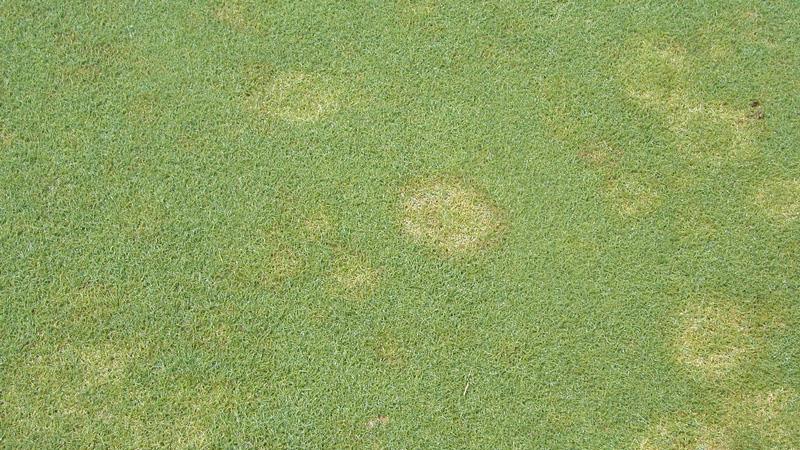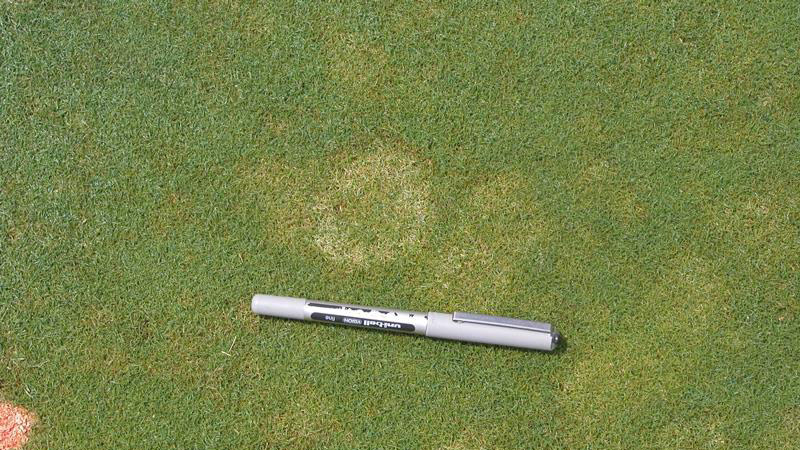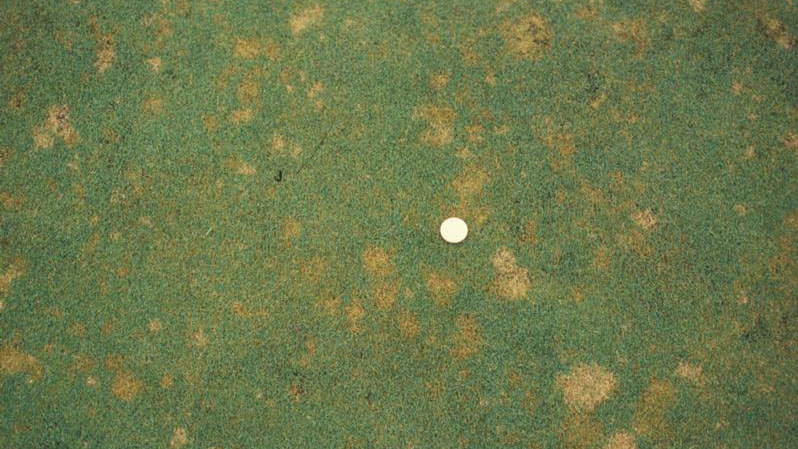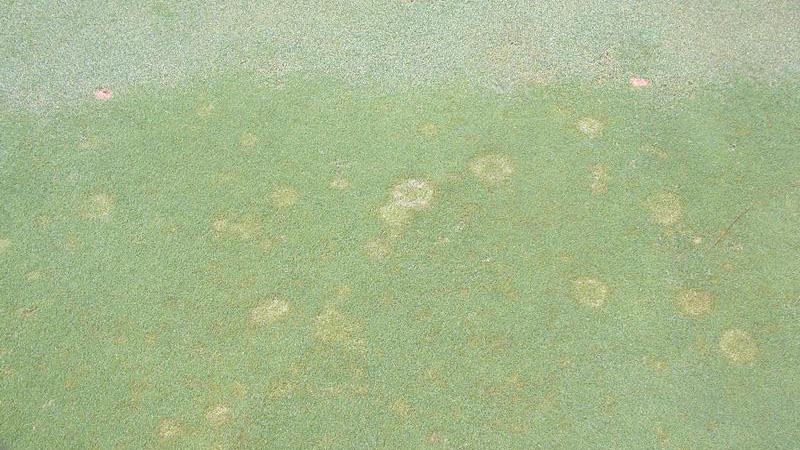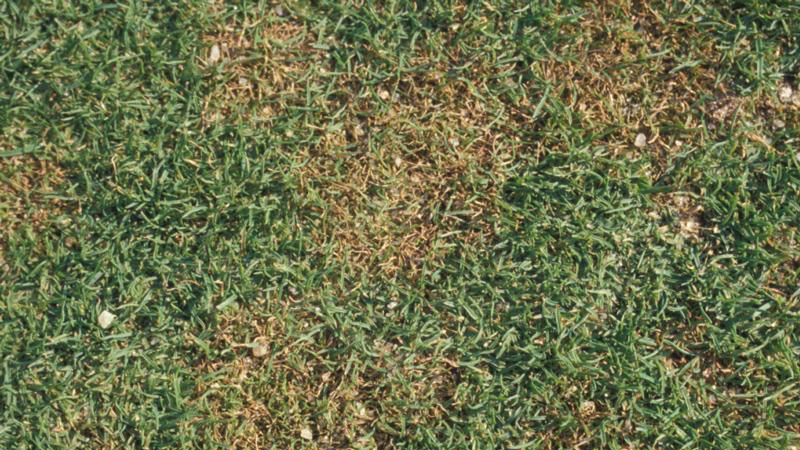Symptoms
Copper spot is a disease of bentgrass species that develops during periods of warm and humid weather. Velvet bentgrass is particularly susceptible to the disease, but it is occasionally observed on creeping bentgrass as well. As the name implies, copper spot appears in small spots, usually less than 3 inches in diameter, that are copper or salmon in color. The disease causes a foliar blight, so distinct lesions or leaf spots are not evident on individual plants. When the turf is wet or humidity is high, the infected leaves may be covered with a thin, gelatinous coating of fungal spores.
Development Factors
Copper spot develops during periods of warm, wet weather. The pathogen is most active when temperatures are between 65 and 85°F. High humidity, frequent rainfall, or over-irrigation favors rapid infection and heavy sporulation. Unlike dollar spot, the development of copper spot is enhanced by excessive nitrogen levels. The disease is also more severe when soil pH is 5.5 or lower.
Cultural Control
Avoid excessive nitrogen by using granular fertilizers with a blend of quick and slow release forms. In general, no more than 0.25 lb of water-soluble nitrogen should be applied to creeping bentgrass at any one time. Removal of dew in the morning by mowing, whipping, or dragging will shorten leaf wetness periods and discourage copper spot development. Practice deep and infrequent irrigation to minimize periods of leaf wetness. Prune or remove trees surrounding golf course putting greens to increase air movement and sunlight penetration. Installation of high-powered fans will also help to minimize copper spot development in areas where air movement is restricted. Creeping bentgrass performs best when soil pH is between 5.5 and 6.5, but pH should be maintained above 6.0 where annual bluegrass is being cultured. Annual soil testing should be used to determine if lime applications are needed to maintain soil pH in this optimal range.
Chemical Control
Little is known about the performance of fungicides for copper spot control. Where the disease has been a persistent problem, apply a labeled fungicide every 14 to 21 days when conditions are conducive to copper spot outbreaks. In other areas, the disease can be controlled curatively if it is detected early. Tank-mixtures of contact and systemic fungicides are most effective after copper spot symptoms appear.
* Products marked with an asterisk are not labeled for home lawn use.
| Fungicide and Formulation1 | Amount of Formulation2 | Application Interval (Days)3 | Efficacy Rating | Resistance Risk | FRAC Code4 |
|
benzovindiflupyr + difenoconazole (Ascernity)* |
1.0 | 14 | ? | ? | 7/3 |
|
boscalid + chlorothalonil (Encartis)* |
4 | 14 | ? | ? | 7/M5 |
|
chlorothalonil (Daconil Ultrex)* |
3.7 to 5 |
14 |
+ | ? | M5 |
| chlorothalonil (Daconil Weather Stik)* | 4 to 5.5 | 14 | + | ? | M5 |
| chlorothalonil (Daconil Zn)* | 6 to 8 | 14 | + | ? | M5 |
| chlorothalonil + acibenzolar-S-methyl (Daconil Action)* | 4 to 5.4 | 14 | ? | ? | M5/P01 |
| chlorothalonil + azoxystrobin (Renown)* | 2.5 | 14 | ? | ? | M5/11 |
| chlorothalonil + fluoxastrobin (Fame C)* | 5.9 | 14 | + | ? | M5/11 |
| chlorothalonil + iprodione + thiophanate-methyl + tebuconazole (Enclave)* |
3 to 4 7 to 8 |
14 to 21 28 |
? |
? | M5/2/1/3 |
| chlorothalonil + propiconazole (Concert)* | 5.5 to 8.5 | 14 | ++ | ? | M5/3 |
| chlorothalonil + thiophanate-methyl (Spectro)* | 3 to 5.76 | 14 | +++ | ? | M5/1 |
|
fluindapyr + flutriafol (Kalida) |
0.25 to 0.4 | 7 to 14 | ? | ? | 7/3 |
| flutriafol (Rayora)* | 0.7 to 1.4 | 14 to 21 | ? | ? | 3 |
| iprodione + thiophanate-methyl (26/36)* | 2 to 4 | 14 to 21 | +++ | ? | 2/1 |
| mancozeb (Fore)* (Dithane)* |
4 to 8 4 to 8 |
7 to 14 10 |
+ | ? | M3 |
| myclobutanil (Eagle) | 1.2 | 14 | ? | ? | 3 |
| tebuconazole (Torque)* |
0.6 to 1.1 | refer to label | ? | ? | 3 |
| thiophanate-methyl (3336) (3336 Plus) |
2 to 4 2 to 4 |
14 14 to 28 |
? | ? | 1 |
| triadimefon (Bayleton) | 0.5 to 1 | 15 to 30 | +++ | ? | 3 |
| 1 Other trade names with the same active ingredients are labeled for use on turfgrasses and can be used according to label directions. 2 Units are oz, fl oz, or lb depending on formulation. Apply fungicides in 2 to 5 gallons of water per 1,000 square feet according to label directions. Use lower rates for preventive and higher rates for curative applications. 3 Use shorter intervals when conditions are very favorable for disease. 4 Fungicide Resistance Action Committe code. Products with same code have the same mode of action and are in the same chemical class. * Products marked with an asterisk are not labeled for home lawn use. |
|||||
| Efficacy Rating ++++ = excellent control when conditions are highly favorable for disease development +++ = good control when disease pressure is high, excellent control when disease pressure is moderate ++ = good control when disease pressure is moderate, excellent control when disease pressure is low + = good control when disease pressure is low ? = not rated due to insufficient data |
|||||
| Resistance Risk Low = Rotate to different chemical class after 3-4 applications; tank mixing not necessary Medium = Rotate to different chemical class after 1-2 applications; tank-mixing with low or medium risk product recommended High = Rotate to different chemical class after EVERY application; tank-mix with low or medium risk product for EVERY application ? = not rated due to insufficient data |
|||||
Species Data
- HOST SPECIES
- creeping bentgrass, annual bluegrass
- MONTHS WITH SYMPTOMS
- April to September
- STAND SYMPTOMS
- spots
- FOLIAR SYMPTOMS LOCATION / SHAPE
- blighting of entire leaves
- FOLIAR SYMPTOMS COLOR
- tan, orange, red, pink
- ROOT / CROWN SYMPTOMS
- none
- FUNGAL SIGNS
- mycelium, jelly-like spore-masses
Publication date: Nov. 10, 2017
Revised: Dec. 16, 2019
Recommendations for the use of agricultural chemicals are included in this publication as a convenience to the reader. The use of brand names and any mention or listing of commercial products or services in this publication does not imply endorsement by NC State University or N.C. A&T State University nor discrimination against similar products or services not mentioned. Individuals who use agricultural chemicals are responsible for ensuring that the intended use complies with current regulations and conforms to the product label. Be sure to obtain current information about usage regulations and examine a current product label before applying any chemical. For assistance, contact your local N.C. Cooperative Extension county center.
N.C. Cooperative Extension prohibits discrimination and harassment regardless of age, color, disability, family and marital status, gender identity, national origin, political beliefs, race, religion, sex (including pregnancy), sexual orientation and veteran status.


